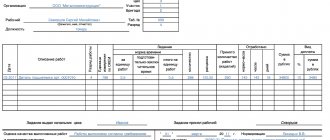Salary remuneration system: concept, advantages and disadvantages, calculation rules
The salary system as a method of paying employees is one of the most used tariff systems in large private and public enterprises. The use of this method of calculation is advisable only with a clear understanding of the principles of its operation and the financial future of the enterprise.
The concept of the salary system
The salary payment system is a type of time-based tariff system, when the salary is set as a monthly fixed amount, which is issued to employees in installments 2 times a month.
This article talks about typical ways to resolve the issue, but each case is unique. If you want to find out how to solve your particular problem, call :
- Moscow.
- Saint Petersburg.
Or on the website. It's fast and free!
The amount of an employee’s monthly income does not depend on the number of working days, holidays and weekends in a month, unless the employee takes time off, extra shifts or goes on sick leave.
Monthly income structure:
- flashing part;
- bonuses and compensation;
- social payments.
The amount of social benefits is determined by law if the employee has benefits and other legal grounds.
The amount of salary and bonus is determined by an employment or collective agreement, while the salary is not subject to change regardless of output, and the employer pays the bonus at its own discretion, depending on the employees’ compliance with labor discipline and implementation of the plan.
In fact, the bonus part, which in most cases ranges from 30 to 100% of the salary, is a tool for punishing or rewarding employees.
It is important to take into account that the total monthly income (salary and all additional payments) cannot be lower than the minimum wage - 11,280 rubles from January 1, 2019. The minimum wage may be increased in certain regions.
Sometimes the salary can be floating and depend on the following indicators:
- employee's length of service;
- qualifications;
- presence of harmful and dangerous conditions at work;
- availability of specialized education.
At the same time, it is important to remember that it is impossible to set different salaries for two employees with the same job functions and the above indicators (Article 132 of the Labor Code).
Areas of use
Basically, the salary payment system is used:
- in state, municipal and government institutions;
- when registering military personnel under a contract;
- when calculating with teams working on a five-day schedule;
- for technical and support personnel;
- for permanent maintenance staff;
- for administrators, accountants , etc.
A monthly fixed salary should not be used for temporary work, as well as for employees whose work results directly depend on their efforts (for the production sector) or the number of clients (for the service sector).
The use of a salary system for workers on a shift schedule is used less frequently due to more complex rules for accounting for weekends and holidays, which preclude automation of the accounting department.
The work of technical personnel (cleaners, storekeepers) is difficult to calculate in volume, so the salary system is also convenient for them.
Payroll rules
An employee’s monthly income under a salary payment system is calculated using the formula:
C = (O + D + P) * (1 – B / N) + 2 * B * (O + P + D) / N,
where O is the amount of salary, D is compensation and social benefits, P is bonus, B is the number of days (hours) that the employee took as time off or spent on sick leave, N is the number of working days (hours) in the month, C is the number overtime working days (hours), which are paid double. The multiplier (O + P + D) / N is the payment for one shift (or one hour) in a given month.
The formula is given without taking into account sick pay, since they are calculated individually based on length of service.
The number of working days in a month on a five-day schedule is calculated by simply adding up weekdays and subtracting public holidays.
In addition to calculating by day, calculation by hour is more often used; in this case, the number of working days is replaced by the number of working hours, and it must be taken into account that the last day before weekends and holidays is shorter by 1 hour.
Calculation by the hour allows you to take into account overtime and days off that last several hours. To calculate working hours, 2 indicators are important:
- working day duration;
- length of the working week.
A working week under a salary system can last 40, 36 or 24 hours.
Example of calculating monthly income
An employee of a team with a 40-hour work week worked 19 days in January 2019, while he was on sick leave for 2 days and went home 4 times 2 hours later due to urgent work. Also, this employee was once 3 hours late, which is why he was deprived of his bonus by 25%. The employee's salary is 20,000 rubles, the bonus is 10,000 rubles, there are no additional payments.
Income for January is equal to (O + D + P) * (1 – B / N) + 2 * B * (O + P + D) / N
In January 2021, there are 17 working days, taking into account all holidays, with a 40-hour working week - 136 hours (N).
Sick hours plus lateness – 19 hours (B).
The number of overtime hours is 4 * 2 = 8 (B).
Prize 10,000 * (100 – 25)% = 7,500 rubles.
The income was (20,000 + 7,500) * (1 – 19 / 136) + 2 * 8 * (20,000 + 7,500) / 136 = 26,893.38 rubles.
The salary system is applicable in large enterprises with a stable income and a large number of employees, as well as for office and service personnel. When using this system, it is important to specify in detail in the collective agreement the grounds for possible deprivation of bonuses.
Loading…
Source: https://pravo.team/trudovoe/oplata/okladnaa-sistema.html
Advantages of the system for company managers
Often different companies establish a salary system for calculating employee earnings. Employee earnings remain unchanged over a long period of time. Therefore, salary payment is automated. For employers, the use of a salary system for remunerating employees has the following positive parameters:
- the company's expenses are clearly planned;
- it is possible to individually encourage any specialists, for which various bonuses, remunerations or additional payments are assigned;
- Due to the fact that the salary does not depend on the company’s income, savings are provided for the organization’s budget.
The disadvantages of using such a system for an employer include the fact that employees lack motivation to increase production or sales. This disadvantage is eliminated by assigning different additional payments or bonuses. Another negative point is that you have to pay not only for working days, but also for weekends.
Time-based wage system
» Remuneration » Time-based remuneration system
The time-based wage system involves calculating wages depending on the time worked. This system is divided into simple time-based, time-based bonus, salary and contract. Let's look at each of them in more detail.
A simple time-based remuneration system is the usual payment to an employee for the actual period of time worked, according to the approved tariff, without taking into account the number of works.
Other remuneration systems:
- piecework;
- tariff-free;
- mixed.
Calculation of payments under a simple time-based system can be carried out according to the following principles:
- Hourly calculation
- Calculation for each day worked
- Calculation per month
For this type of payment, it is required to maintain time records of the time interval worked. It is also necessary to separate tariffs by rank and position in accordance with regulatory documents. Standards are being determined that could regulate the work of time workers. Workplaces must comply with standards that ensure labor efficiency.
The most significant disadvantage of a simple time-based system is that it provides the least incentive for staff to complete tasks effectively, since the amount of payment does not depend on the result of work.
Time-bonus wage system
Time-bonus wages are a time-based simple payment supplemented by a bonus for high quality performance indicators. The payment of bonuses is subject to the established principles of bonuses written down in the collective agreement.
The size of the bonus is determined according to the timing and quality of work performed. The employee will receive a bonus only if the conditions for the bonus are met.
Often this type of payment is practiced when calculating wages not only for management and specialists, but also for a huge number of ordinary workers.
Salary system of remuneration
Salary payment is a system according to which the employee’s salary is calculated at a fixed monthly rate. Unlike time-based, it does not take into account the fact that different months have different numbers of working days.
But if the number of days actually worked is less (due to sick leave) than the number of days that needed to be worked, wages are calculated based on the sum of the daily pay and the amount of time actually worked.
With this type of remuneration, a system of bonuses and additional payments, which are provided for by law, is also assumed. Additional payments can be made for overtime work, night work, downtime during multi-machine patronage due to major repairs, refilling, refueling, and cleaning. Additional payments are also provided to nursing mothers with children.
To summarize, we can say that the amount of wages calculated using the salary method consists of a monthly rate, bonus and additional payments.
Contract wage system
Contract is a system that involves signing a contract between an employee and an employer for a certain period of time.
When an employee is hired, a contract (in this case an employment contract) must be concluded in writing and secured with appropriate signatures and a seal. Only in this case will it have legal force.
The contract contains information such as its validity period, working conditions, rights and obligations of the employee and employer, working hours, and the amount of remuneration. The sanctions that will be applied in the event of premature termination of one of the participating parties must be prescribed.
The contract can be concluded for the period of the employee’s stay in the organization and represents time-based payment, or for a volume of work or a specific task with a limited time frame, which is piecework payment.
The contract system provides for various additional payments and bonuses that are due to an employee for a high level of qualifications, mastery in a given profession, and for extreme working conditions. This clause must also be stated in the text of the contract.
| Didn't find the answer to your question in the article? Get instructions on how to solve your specific problem. Call the phone right now: +7 – Moscow – CALL +7 – St. Petersburg – CALL +8 (800) 500-27-29 ext.849 – St. Petersburg – CALL here – if you live in another region. It's fast and free! |
Source: https://rabotniks.ru/povremennaya-sistema-oplaty-truda/
System Features
The salary system of remuneration is considered simple to calculate, since the calculation requires adding up the salary per month with different bonuses and additional payments. The earnings of each employee of the company consists of a fixed part, represented by salary, as well as a variable part, which is various additional payments, allowances or other payments.
Additional payments are assigned in certain situations, which include:
- the specialist is engaged in his work duties at odd hours;
- a citizen works on holidays or weekends;
- engages in labor activity at night;
- benefits are provided to mothers or pregnant women;
- work is carried out in harmful or completely dangerous conditions;
- teenagers get jobs;
- accrual of money for downtime associated with equipment repairs.
The salary is assigned without the influence of the above factors, so its amount remains unchanged.
Salary system of remuneration - what is it according to the Labor Code of the Russian Federation
— Business organization — Personnel — Salary system of remuneration
The most common in Russia among all methods and methods of calculating wages is the salary system of remuneration.
and is the most convenient in many aspects for both employees and employers, which makes it so popular.
It will be useful for any party to the labor relationship to know how wages are set and what advantages and disadvantages they have.
What is the salary labor system according to the Labor Code of the Russian Federation - legislative regulation
As one of the most common in Russia, the salary labor system looks the simplest for most employees. It implies the trivial performance by an employee of his work duties with the receipt of a fixed monthly salary, regardless of other additional factors, at least at its core.
It should be remembered that salary and salary are not identical terms.
The concept of wages, as well as average earnings, includes all types of cash accruals from the employer, including bonuses, additional payments, overtime and other types of direct or indirect remuneration that can be reflected in monetary terms.
Salary is an established fixed salary, obligatory for accrual by the employer within the established time frame for payment of wages.
Legal regulation of the salary mechanism is provided by a fairly large number of articles of the Labor Code.
In particular, it is the salary as a system of remuneration that is considered most often by this regulatory document, while other possible methods of calculating wages do not have standards precisely defined by the provisions of the Labor Code of the Russian Federation. Thus, the employer and employees should necessarily take into account the provisions of the following articles of the Labor Code of the Russian Federation in matters of such a remuneration system as salary:
- Art.57. Its standards indicate that it is mandatory to indicate in the employment contract the current principles of remuneration for the employee, including the salary system.
- Art. 129. These standards define the very concept of salary as a fixed standard of remuneration paid for an entire calendar month of performance of labor duties.
It should be remembered that the salary system of remuneration is one of the varieties of the time system
.
At the same time, in this case, a whole month is taken for the period of work under consideration, however, working days when the employee did not carry out work activities are ultimately still not subject to payment, but are recalculated accordingly.
The time-based system is, in turn, a subtype of the tariff system of remuneration. Accordingly, any enterprise that offers its employees the use of a salary system must have an appropriate tariff schedule.
Advantages and disadvantages of the salary labor system
Like other options and types of remuneration, the salary system has certain characteristics that make its use in some situations extremely effective and, conversely, extremely inconvenient in other cases. So, the advantages of salary include the following factors:
- Easy to use. The salary system is one of the simplest and most universal in matters of drawing up an employment contract, personnel documentation and accounting reporting. In particular, it assumes the need only to count the days of temporary incapacity for work or the employee’s absence from the place of performance of work duties for other reasons.
- Reduced costs. The use of a salary labor system due to its simplicity does not require the implementation of complex accounting systems and large costs for personnel records management, which significantly reduces the costs associated with its implementation and operation, especially in comparison with such complex options for organizing payroll as an hourly payment system.
- High level of stability. For employees, one of the main advantages of the salary system is the highest level of income stability. That is, they will always be confident that they will receive at least the amount of funds determined by their salary, regardless of most other circumstances. The employer, in turn, always has the opportunity to predict in advance mandatory fixed labor costs.
- Low staff turnover. This advantage of the salary system directly stems from the above. Due to high stability, employees do not want to risk their earnings and prefer to improve their skills and plan future career growth within the company to increase their own income. Piece-rate remuneration in comparison with salary does not stimulate workers for long-term relationships with career growth, but only directs them to a direct increase in personal productivity at the immediate moment.
- Wide range of applications. The salary system, albeit with less efficiency, can be applied to absolutely any positions and employees, while other methods of remuneration are completely inapplicable in certain cases. Therefore, it can be installed even on a temporary basis when preparing additional documentation on changes in the remuneration mechanism.
In addition to the positive aspects, the salary also has negative features. In particular, the disadvantages of the salary system traditionally include:
- Low level of motivation of workers. In itself, the motivation of employees is the lowest in the salary system - practically no basic labor factors influence the amount of funds payable by the employer. This feature directly affects all types of time-based payment, in contrast to piece-rate systems. However, the salary-bonus system can significantly neutralize the impact of this disadvantage if used properly.
- The need to pay for non-working days. With a salary labor system, the established salary is paid monthly, without dividing the amount of payment depending on the number of working and non-working days in one month. Accordingly, this factor cannot have a positive impact on minimizing the costs of the enterprise.
- Increased risks. Due to the mandatory payment of salaries to employees, they must be paid in full, determined by the employment contract or current tariff rates, regardless of the prevailing market circumstances. As a result, during periods of crisis, an enterprise may simply not have enough funds to cover the total costs of providing a payroll fund.
Taking into account the indicated features of the salary payment system, the employer can make a full conclusion about the feasibility or lack thereof in relation to the introduction of such a remuneration system as salary at the enterprise.
What you should know about the salary system of remuneration for employers - the main nuances and features
The procedure for appointing and changing the established wage system requires mandatory indication of information about it in the local regulations of the organization itself, as well as directly in the employment contract with the employee.
If these changes must be made to a previously concluded employment contract, the employer should prepare an additional salary agreement, which is signed by both parties to the relationship on a purely voluntary basis - however, if the employee refuses to sign and refuses to occupy other positions in the enterprise, he may be fired.
The salary system for shift work also has certain regulatory nuances. It is not preferable for the employer in this case - a transfer to an hourly wage would look much more profitable and convenient for all parties to the labor relationship.
However, if you need to use the salary for shift work, you should first calculate the number of shifts per month. If they increase, it is recommended to recalculate the salary volumes, while if they decrease, such recalculation is unacceptable.
The very procedure for assigning a salary system requires the compulsory drawing up of a tariff schedule regulating the amounts of salaries and wages for workers with different skill levels and in different positions.
The salary-bonus payment system may also imply the presence at the enterprise of a provision on bonuses or other internal regulatory document regulating the procedure for assigning bonuses and additional payments to employees.
The law prohibits setting employees' wages below the minimum wage, but the employer can be held liable only if there has been a failure to pay the employee the appropriate amount of money for a certain period of work. Thus, the salary itself may be lower than the minimum wage, provided that the difference is compensated through other payments and bonuses
How is the system used in companies?
If an employer decides to use a regular wage system, then he must understand how it is established at the enterprise. To do this, the following nuances are taken into account:
- the system is introduced by a collective agreement or an internal regulatory act of the organization;
- if there is a trade union at the enterprise, then its opinion must be taken into account when introducing such a scheme;
- the salary is set in the form of a fixed amount, which is paid if the employee works the required number of hours in the company;
- For each specialist, the salary is determined individually, since his work experience, qualifications, complexity of activity and other significant factors are taken into account;
- different skills and abilities of an employee can be taken into account separately or in combination, so the salary of employees occupying the same position may differ slightly or even significantly;
- If the same salary is set for all employees of one position, then the earnings of specialists are regulated by assigning different additional payments and bonuses, for which the qualifications or complexity of the work are taken into account.
Therefore, the application of the salary system is considered a rather complex process, since the employer must take into account many nuances so as not to offend any employee in any way.
Calculation examples
The peculiarity of the salary system is that the calculation is simple if there is accurate information about how much time the specialist worked per month. The company may not provide additional payments to employees, so specialists can only receive a constant salary.
For example, the company has introduced a salary system. All employees receive the same salary, equal to 20 thousand rubles. per month. One specialist worked completely for the entire month, but one day was spent on field activities, for which he was given a bonus of 3 thousand rubles. Therefore, his earnings will be 23 thousand rubles.
What it is
The salary system is one of the methods of calculating wages, which is a type of time-based wages.
This system has another name - fixed wages. Regardless of the number of working days in a month, wages remain unchanged (we are talking about salary without bonus). For example, wages in February, where there are only 20 working days, will be equal to wages in April, where there are 23-24 working days.
Of course, if a person did not work all the expected days, for example, due to sick leave, his salary will be reduced. In this case, the amount of the monthly salary is calculated taking into account the number of days worked and the amount of daily earnings.
If the month is not fully worked, then wages are calculated based on the salary, in proportion to the number of days or hours worked.
The formula for the salary system is as follows: monthly salary + additional payments + bonuses.
Features of the salary system
The salary consists of a salary, that is, a fixed amount, but the accrual of bonuses and other additional payments that are permissible in the Russian Federation is not excluded.
Typically, surcharges are assessed in the following cases:
- work outside of school hours;
- work on holidays and weekends;
- work at night;
- benefits for mothers and pregnant women;
- unhealthy working conditions;
- adolescent labor;
- charges for downtime due to repair work.
The salary amount is determined by the position held and may depend on the following:
- specialist qualification;
- existing awards and degrees conferred;
- length of service;
- Foreign language skills;
- increase in work volume;
- work with a smaller number of employees, these conditions are specified in the employment contract;
- combining several professions;
- experience;
- education.
In order to qualify for a higher salary, you need to earn it. It was described above in which cases the director of an enterprise can revise wages.
To do this, you need to undergo certification and conduct research according to the level of salaries in this field of activity.
Salaries are calculated using two methods:
- At a specific enterprise. We are talking about private enterprises.
- The entire industry. If the enterprise is owned by the state.
Also, the size of the salary is greatly influenced by the industry in which the person works and the specific region.
With a salary system, an employee can also receive social benefits, which are called benefits.
But this is not a salary increase, but so-called privileges, for example, discounts on utility bills and child education fees. Thanks to them, an employee can save money when paying for some services.
Article 129 of the Labor Code also determines the base salary, which refers to the payment of the minimum salary with allowances.
The minimum salary can be determined both for a group of employees and for each individual, based on his job responsibilities.
You can find out what a time-based form of remuneration is in the article: time-based form of remuneration.
Where the non-tariff wage system is used is described in this article.








